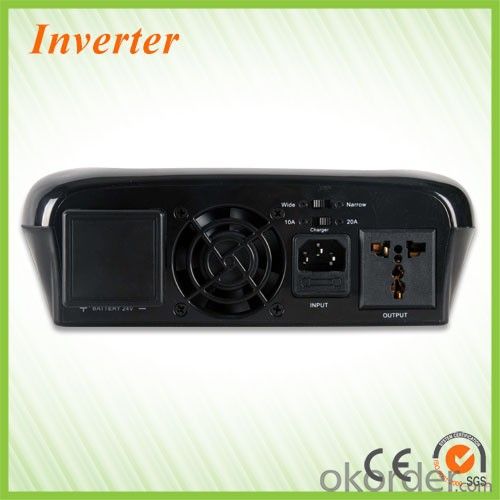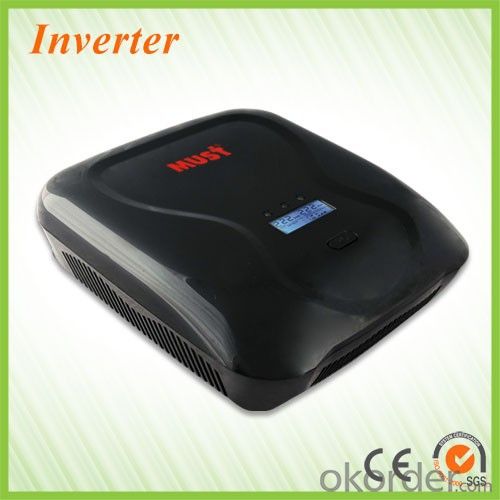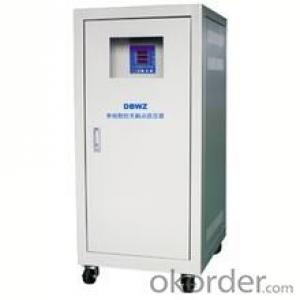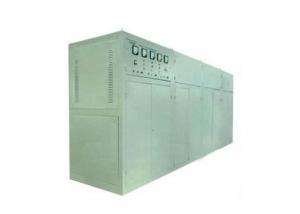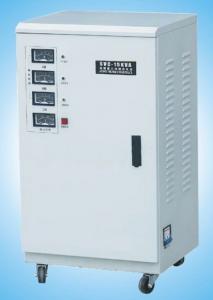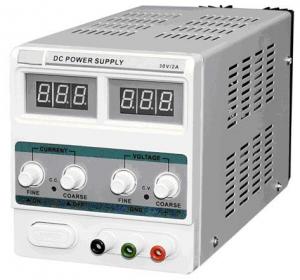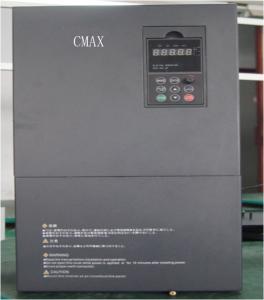Three-Phase Stabilized Power Supply With Fully-automatic Compensation
- Loading Port:
- China main port
- Payment Terms:
- TT or LC
- Min Order Qty:
- 1 pc
- Supply Capability:
- 1000 pc/month
OKorder Service Pledge
OKorder Financial Service
You Might Also Like
SBW 20-320KVA
SBW Three-Phase Stabilized Power Supply with fully-automatic compensation is suitable for the electric network with unbalanced three-phase voltage inputs. It can balance three-phase outputs automatically and maintain the output in good condition during the fluctuation of electric network and load.
Model | SBW (Independent regulator voltage) | SBW(Dependent regulator voltage) | |||||||
VA Rating | 20KVA | 30KVA | 50KVA | 100KVA | 50KVA | 100KVA | 180KVA | 225KVA | 320KVA |
Input | |||||||||
Phase | Three Phase+N+GND | ||||||||
Voltage Range | Phase voltage 220V±20%、Line voltage 380V±20% | ||||||||
Output | |||||||||
Voltage Range | 220V AC (Phase Voltage)、380V AC (Line voltage) | ||||||||
Voltage Precision | ≤±3% | 2%~5% (adjustable) | |||||||
Frequency | 50/60Hz | ||||||||
Efficiency | ≥95% | ||||||||
Others | |||||||||
Protection | Overvoltage, overcurrent, loss of phase, phase-sequence and mechanical failure protection | ||||||||
Noise(dB) | ≤50 | ||||||||
Display Mode | LED Indicator Light; Pointer voltmeter | ||||||||
Input/Output Connection | Terminal Block | ||||||||
Waveform Distortion | No additional waveform distortion | ||||||||
Response Time | ≤1.5s(External voltage change 10%) | ||||||||
Insulation Resistance | ≥2MΩ | ||||||||
Dielectric Strength | Low frequency sine voltage 1500 for 1 minute (without the phenomena of breakdown and flashover) | ||||||||
Overload Capacity | 120% of rating current >10s | ||||||||
Ambient Temperature | -10℃~+40℃ | ||||||||
Relative Humidity | 20%~85% | ||||||||
Working | Continuing Working | ||||||||
Dimension(W×D×H)mm | 730x485x1110 | 810x570x1410 | 990x620x1530 | 800x600x1520 | 900x700x1660 | 1100x835x1830 | 1100x850x1830 | 1240x900x2109 | |
Net Weight (kg) | 160 | 185 | 245 | 410 | 280 | 415 | 645 | 765 | 945 |
Packing Dimension(W×D×H)mm | 780x555x1160 | 860x640x1460 | 1040x690x1580 | 850x670x1570 | 950x770x1710 | 1150x905x1880 | 1150x920x1880 | 1290x970x2159 | |
Gross Weight (kg) | 175 | 200 | 266 | 435 | 310 | 439 | 673 | 810 | 995 |
· Q. What is an UPS and What it is for ?
An uninterruptible power supply (UPS) is a device that allows your computer or telephone switch or critical equipement to keep running for at least a short time or longer time when the primary power source is lost. It also provides protection from power surges, spikes, brownouts, interference and other unwanted problems on the supported equipment.
· Q. How long the UPS to run when power goes?
This can take 3 paths.
1.You can pick a UPS that is rated for pretty much the full VA you need so it will be running at 100% of capability and will thus last 'n' minutes.
2.You can pick a UPS that is rated at a much higher VA value than you really need so, for example, is running at 50% of capability and will thus last for longer than the UPS from option 1.
3.You can use extra external battery packs to run for longer. If charging capability allows, the more and the bigger batteries you take with, the longer time UPS runs.
or using a generator after about 6 hours, it will be more cost-effective, with a short runtime UPS to bridge the generator start-up gap.
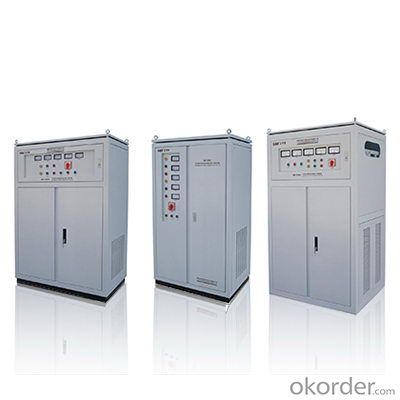


- Q: Can a solar inverter be used with a string inverter system?
- No, a solar inverter and a string inverter system are two different types of inverters used in solar power systems. They cannot be used interchangeably as they have different functionalities and are designed for different types of solar installations.
- Q: Can a solar inverter be used in a three-phase power system?
- Yes, a solar inverter can be used in a three-phase power system. In fact, three-phase solar inverters are commonly used in commercial and industrial applications where the power demand is higher. These inverters are designed to convert the direct current (DC) generated by solar panels into alternating current (AC) that is compatible with a three-phase power system.
- Q: Can a solar inverter be used in areas with high temperature fluctuations?
- Solar inverters can generally be used in areas that experience high temperature fluctuations. These inverters are designed to function within a wide temperature range, usually between -20°C to 50°C (-4°F to 122°F), depending on the model. They incorporate temperature protection mechanisms to guarantee their durability and functionality, even in the face of extreme temperature variations. However, it is essential to acknowledge that prolonged exposure to extreme temperatures at the upper or lower limits of their operating range may impact the inverter's performance and lifespan. Consequently, it is crucial to install them correctly and perform regular maintenance to ensure optimal performance in regions with significant temperature fluctuations.
- Q: How does a solar inverter handle grid disturbances (voltage sags, swells, flickers)?
- A solar inverter handles grid disturbances such as voltage sags, swells, and flickers by continuously monitoring the grid's voltage and adjusting its output accordingly. When a voltage sag occurs, the inverter increases its output voltage to compensate and ensure a stable power supply. Similarly, during a voltage swell, the inverter reduces its output voltage to prevent overloading the system. In the case of flickers, the inverter rapidly responds by regulating its output to minimize any fluctuations and maintain a consistent power flow. Overall, the solar inverter's advanced control mechanisms enable it to effectively manage grid disturbances and ensure reliable operation of the solar power system.
- Q: How does a solar inverter handle voltage and frequency variations caused by voltage sags and swells?
- A solar inverter is equipped with various mechanisms to handle voltage and frequency variations caused by voltage sags and swells. When there is a voltage sag or swell in the electrical grid, the solar inverter employs a technique called Maximum Power Point Tracking (MPPT) to regulate the power output from the solar panels. During a voltage sag, when the grid voltage drops below the normal level, the solar inverter adjusts its MPPT algorithms to ensure that the solar panels continue to operate at their maximum power point. This enables the inverter to extract the maximum available power from the panels and compensate for the reduced grid voltage. By dynamically adjusting the operating point of the panels, the inverter mitigates the effects of the voltage sag and maintains optimal power output. Similarly, in the case of a voltage swell, when the grid voltage increases above the normal level, the solar inverter again utilizes its MPPT capabilities to regulate the power output. It adjusts the operating point of the panels to ensure that they do not exceed their rated voltage, thereby protecting them from potential damage. This allows the inverter to effectively handle the increased grid voltage and prevent any adverse effects on the solar panels. In addition to voltage regulation, a solar inverter also addresses frequency variations caused by voltage sags and swells. It is designed to synchronize with the grid frequency and maintain a stable output frequency. When the grid frequency deviates from the normal range, the inverter adjusts its internal control systems to match the grid frequency. This synchronization ensures that the power output from the inverter aligns with the grid requirements, allowing for seamless integration of solar energy into the electrical system. Overall, a solar inverter utilizes MPPT algorithms, voltage regulation mechanisms, and frequency synchronization capabilities to handle voltage and frequency variations caused by voltage sags and swells. These features enable the inverter to adapt to changing grid conditions, maximize power extraction from the solar panels, and maintain a stable and reliable power output.
- Q: What is the maximum power capacity that a solar inverter can handle?
- The maximum power capacity that a solar inverter can handle depends on its specific model and specifications. In general, solar inverters can handle power capacities ranging from a few hundred watts to several megawatts, catering to various residential, commercial, and utility-scale solar installations.
- Q: Three-phase photovoltaic inverter grid, the use of phase-locked loop is what?
- Grid-connected inverter can be operated locally through the LCD screen, or through remote monitoring with dedicated monitoring software.
- Q: What is the maximum efficiency of a solar inverter?
- The maximum efficiency of a solar inverter typically ranges from 95% to 98%.
- Q: What are the key factors affecting the lifespan of a solar inverter?
- The key factors affecting the lifespan of a solar inverter are the quality of components used, the level of maintenance and care, the operating environment, and the overall design and build quality of the inverter.
- Q: Can a solar inverter be installed indoors or outdoors?
- A solar inverter can be installed both indoors and outdoors, depending on the specific requirements and preferences of the installation. However, it is essential to consider factors such as available space, ventilation, temperature regulation, and protection from environmental elements when deciding on the installation location.
Send your message to us
Three-Phase Stabilized Power Supply With Fully-automatic Compensation
- Loading Port:
- China main port
- Payment Terms:
- TT or LC
- Min Order Qty:
- 1 pc
- Supply Capability:
- 1000 pc/month
OKorder Service Pledge
OKorder Financial Service
Similar products
Hot products
Hot Searches
Related keywords





